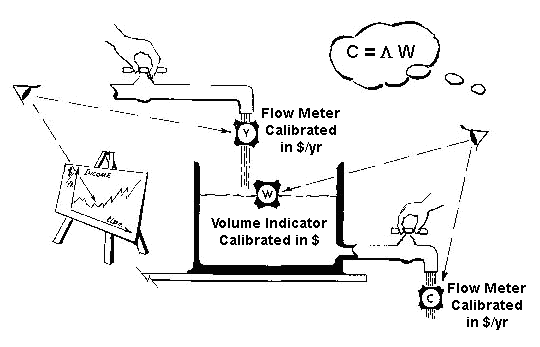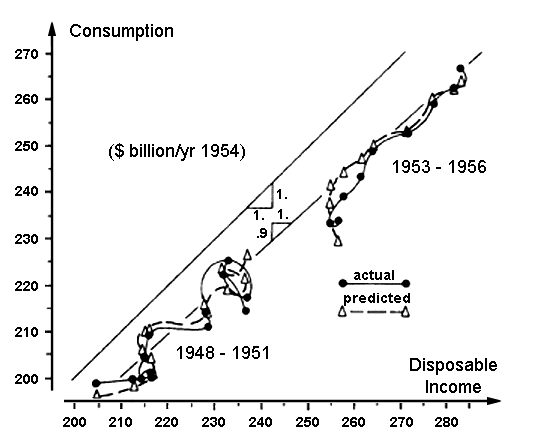Professor Gardner Ackley’s Macroeconomic Theory continues to serve our exposition by detailing the Keynesians’ most cogent objection to SFEcon. Ackley’s performance in regard to the Marginal Propensity to Consume MPC is shot through with one rejection after another of a simple model wherein consumption is a delay on income. Simple delays being the essential device by which monetary flows regulate an SFEcon model, their well-advertised deficiency does, to the extent that it might be credited, make our project ridiculous.
Professor Ackley credits Professors James Duesenberry and D. H. Robertson for attempting to explain the erratic short-run behavior of the consumption function through various formulations of mathematical delay, but the conclusion is that ...
no simple lag function appears to improve the explanation of short run consumer behavior.1
He also credits Professor Dan Patinkin, Professor Arthur Cecil Pigou (whose work was an object of ridicule in the General Theory) and others for introducing the wealth variable as a partial explanation for the intransigent nature of consumer's behavior. The last words are, however, given to Professors Thomas Meyer and Alvin Hansen:
the Pigou effect is in practice of little empirical significance.2
If consumption were a simple lag on income, its dynamics could be analogized by the device shown below.

Pigou’s wealth variable W is represented by the level of a fluid reservoir, and income Y is the rate at which the reservoir is filled. The fill rate would be controlled by analogy to a real historical series of income data, i.e.: so many gallons per minute representing some number of dollars per year. A simple delay on the income series Y is effected when the reservoir’s effluent rate C is regulated in proportion to the wealth level W:

The proportion between C and W would correspond to the constant
L by which an economic system might, in the most general sense, propel its stocks of value.Empirical investigation of the delay model requires application of numerical methods techniques to integrate the wealth variable W’s response as it is driven by an actual income stream Y:

The investigation would then compare the model’s consumption stream C with actual consumption. A failure of reasonable correlations in such models, as reported by the Keynesians, would falsify the essential premises by which SFEcon manages its financial flows.
Results from such experiments are reported in Chapter 2 of Roemer's Newtonian Economics (1985) as a means of exhibiting the general virtues of dynamic systems analysis. In one experiment the income stream Y was given by the same 22 data points that Ackley compiled for his highly equivocated defense of Keynes’ MPC. The result was presented in the income vs. consumption plot below.

Correlations between actual and model-predicted consumption are 0.891 for the 1948-51 period and 0.966 for 1953-56. (Ackley eliminated data for the Korean War period, 1951-53.)
As this result was both statistically appealing and derived from a very simple idea, Roemer
went on to test the delay formulation on data from earlier and later periods. His results for the
1961-70 period yielded a 0.982 correlation between actual and predicted consumption. Using a
somewhat different formulation to express his notions about depression economics, Roemer was able
to establish a 0.931 correlation for 1929-38. In all these experiments the parameter
L was kept constant at 0.95.
Thus was created the strawman for Roemer to demolish in his argument for an economics that is more
attentive to right religion in the analysis of dynamic phenomena. Creditable opinion discredits the
delay model of income vs. consumption even though its empirical reliability approaches that of its
referent data. Economics thereby deprives itself of a simple, familiar formulation (two equations
and one parameter) in favor of Ackley’s 99 pages in three chapters for the sake of an MPC that
is constant in the degree portrayed
earlier <recall illustration>.
Roemer's experiments with the delay formulation worked because he (unlike Pigou, Patinkin, Duesenberry, Robertson et al?) paid proper attention to the interval by which the income and consumption data were organized in relation to the delay parameter L. Roemer came to these experiments with a prejudice that the proper setting for L would be approximately 0.95 per year, a typical value now for a monetary unit to be delivered in one year. (The logic behind Roemer's supposition is set forth in connection with our discussion on the velocity of value.)
Having concluded as to a working estimate of L = 0.95/year, Roemer knew that simulating a delay on income Y would only be worthwhile if the discrete elements of the Y series were refreshed at a rate of 10 per year or greater (which would be 1/10 or less of the system’s natural period 1/L, according to the dynamicist's rule of thumb). Since the Y series was only reported at quarterly or yearly intervals, the raw data had to be artificially disaggregated into a monthly series for the sake of keeping the experimental machinery from resonating with the data driving it.
Anyone adequately trained in simulation techniques would have taken this precaution. It is analogous
to choosing the film speed for a moving picture camera. If the period of the camera's shutter opening
and closing approaches that of any natural frequency in the action being filmed, then the resulting
portrayal of motion will have nothing to do with what was before the camera. This phenomenon is visible
in films of turning wagon wheels or accelerating propellers. And it would account for the dismal reports
as to the delay-on-income model's validity: the Keynesians might well have been emphasizing
unintentionally induced experimental noise over Pigou's perfectly valid theoretical
insight.
1 Gardner Ackley, 1971; p. 265.
2 Ibid; p. 272.